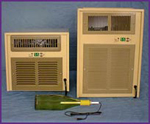Wine cellar cooling units can rightly be considered the cornerstone of a proper wine storage environment. There are many other factors that impact the effectiveness of a wine cooling unit, however. The following are more facts about wine cellar cooling units, including information about other components that affect how the unit performs.
1-Vapor Barrier
During construction of a wine cellar, it’s essential to include a vapor barrier or vapor retarder. Because sudden or frequent temperature and humidity fluctuations in a wine cellar can damage wine, the vapor barrier and insulation are both of tremendous importance. A vapor retarder prevents warm air from entering the cool environment in your wine cellar. Various factors determine the thickness, finishes, and applications of a vapor barrier. Those factors include the size, capacity, and location of your wine cellar. The vapor barrier must be installed on the warm side of the wall, and the process must be thoroughly done. The effectiveness of the vapor barrier impacts the performance and effectiveness of the wine cellar cooling unit.
2-Insulation
Professionals in wine cellar construction understand the unique role insulation plays, to ensure that wine cellar cooling units can do the job they are designed to do. Insulation must be properly installed in the walls, floors, doors, and windows. The requirements for insulation are determined by the outside wall the cellar occupies and the depth of the cellar below grade. Some of the challenges to proper wine cellar insulation include ductwork, plumbing pipes, and electrical wirings.
3-Drain Line
Another important aspect of a wine cellar that many people don’t know about is the condensate drain line. The condensate fitting and tube allows overflow condensation to exit from underneath the wine cellar cooling unit. The drain line must be connected at all times, so that the walls and other wine cellar components aren’t damaged by water. Maintaining the proper temperature and humidity in a wine cellar requires a drain line. However, when a wine cellar is built properly, condensation is minimal.
4-Electrical Circuit
The electrical work on a wine cellar is also important, to ensure that the cooling unit can perform at an optimal level. A dedicated electrical circuit helps to minimize the risk of a tripped circuit breaker. If the electricity ever went out for a prolonged period, it could mean the wine environment is altered and the wine is spoiled.
5-Maintenance Required
Previously in this two-part series it was mentioned that wine cooling units operate up to 70% of the time. Quality wine cellar cooling units, such as those made by manufacturers Breezaire and WhisperKOOL, can be depended upon to work dependably usually for 35,000 hours before any type of mechanical service is required.
All of the essential elements of building a quality wine cellar have an impact on the wine cooling unit. When you trust professionals like the wine cellar construction experts at Rosehill Wine Cellars, you can be confident of top quality results. Contact Rosehill Wine Cellars today to get started on your own wine cellar in southern Ontario. Recommendations will be made on the best wine cooling unit to choose, based on the specifics of the wine cellar itself.






